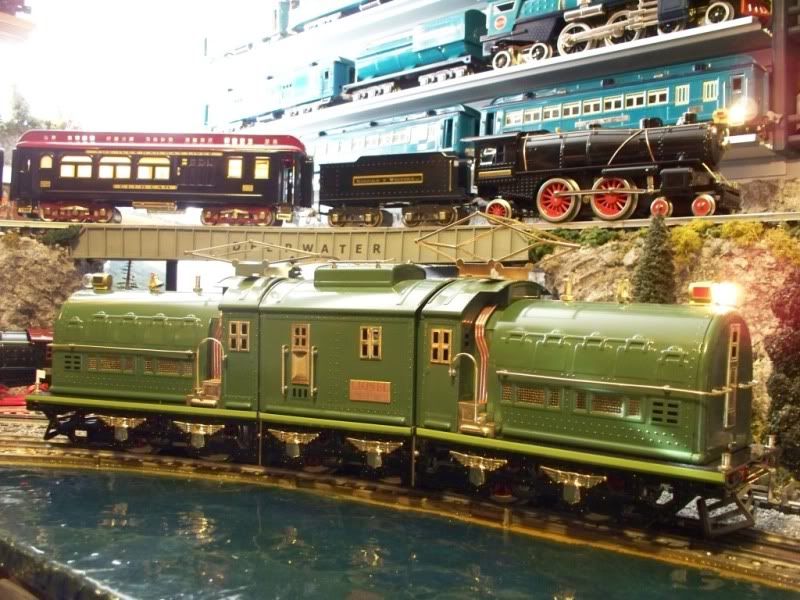I'm building a Standard Gauge club layout that will incorporate a tunnel. What is your experience with the maximum height of Standard Gauge locomotives and rolling stock, and necessary tunnel clearances? I'm looking to allow for the tallest possible thing someone might bring in. So far the tallest items I've seen are the Super 381 and Ives 3245 electrics, which should be a bit under 7 inches with the folding pans erected. So, I'm thinking that 8 to 8-1/2 inches head clearance should be enough. Comments? Anybody got an oddball item taller than 7 inches?
Replies sorted oldest to newest
The Brute will need 9 3/4.


Scott Smith
I just checked the tunnel height on the SGMA mountain (9 3/4) did not know the Brute was that close.
A STG Toonerville Trolley is something like 14". However, with substantial binding it does go around 31 STG track.
The SGMA never established a standard for vertical clearance, but we did have several discussions. A survey of members revealed that we might need as much as 10.5 inches of vertical clearance. This would allow all existing Standard Gauge rolling stock (except for the Toonerville Trolley) to run. Unfortunately, 10.5" is a rather gaping hole!
Thanks to all who have replied so far. I appreciate the info on the Brute - for a number of reasons, we are going to leave that one out of the mix for this layout. No one in our museum/club contemplates buying one, and to build a layout that would accommodate it would require some clearances that would be very hard to build in. Ditto the Toonerville Trolley - if we wanted to run that, we'd really have to do without the tunnel altogether!
SGMA 1 - You mention 10.5 inches. Can you recall any specific examples of equipment requiring more than 8.5-9 inches of clearance? Thanks.
Looks like I will be getting the jig saw out again.
Hiawatha,
My prewar Lionel Std. Gauge tunnels are right about 10.50". My Flyer tunnels are right at 9.50". All my cars fit with plenty of room, even my State cars. Remember to subtract your ballast height if you're using it. If you plan to use any of the track prewar sound deadening cushion you'll lose about .25". Good luck with you endeavour.
As Kirk mentioned, 10.5" is the unoffical vertical clearance that SGMA uses. The problem is typically associated with "raised" pantographs on engines like my Standard Gauge RichArt Cascade BiPolar. Unfortunately, not all engine's pantographs, such as those on the Brute, can be lowered.
I should note that this vertical clearance problem is not restricted to just tunnel portals but can occur with other classic Standard Gauge accessories such as Lionel's classic Standard Gauge tinplate signal bridge. For example, to achieve 10.5" of vertical clearance on my SGMA modules I had to raise up my Lionel signal bridges by placing them on platforms.
Fortunately, some help on this issue is in the works. Specifically, a select group of SGMA members is currently collecting vertical clearance data as well as horizontal "overhang" and "underhang" clearance data on Standard Gauge trains. Hopefully, preliminary results from their research will be posted in the near future on SGMA's website. I recommend you join SGMA to stay abreast of the latest research on these vertical and horizontal clearance issues!
My Lionel 140L portal height is 10" from ground to the highest entrance point of the portal.
Ron M
HI,
There is no real standard, but using the tallest gear available to me, I decided that 8" was enough to clear most anything... so far so good.
My 440 bridge had 10.25" of clearance.
Me and Bob N must have the short version of the signal bridge. I measure 9 1/2" above rail height with Johnsons roadbed under the track.
Me and Bob N must have the short version of the signal bridge. I measure 9 1/2" above rail height with Johnsons roadbed under the track.
Jim,
The signal bridges I'm using on my SGMA modules are the Lionel Classics versions. To get a minimum of 10.5" of clearance above the center rail, I had to place the two "legs" of the signal bridge on separate platforms, i.e., two tinplate platform extensions that came with my ACE train station canopy kits.
Bob
Dont forget to fold the pantographs up on those 3245s and 381s before measuring. Makes for a bad day if one pops up during running and is sheared off by the tunnel.
I found it interesting that real electric locos always run with the front panto down and the rear raised. This was so if the front was torn off it would not carry the rear away with it. So now all my electrics run with the pantograph facing the back.
Me and Bob N must have the short version of the signal bridge. I measure 9 1/2" above rail height with Johnsons roadbed under the track.
The short Version? Funny guy.
With Johnsons and rail added my "tall version" will clear about the same 9.5 inches
I found it interesting that real electric locos always run with the front panto down and the rear raised. This was so if the front was torn off it would not carry the rear away with it. So now all my electrics run with the pantograph facing the back.
That depends on the railroad and the specific locomotive. The Milwaukee Road ran the Bi-Polars with the rear pan raised for exactly that reason. The pans on a Bi-Polar are very close together, immediately ahead of and behind the center cab. On the other hand, Little Joes and multi-unit boxcabs were typically run with the forward pan raised, because there was much more distance to the rear pan. Check out some prototype photos, there's quite a bit of variation.



